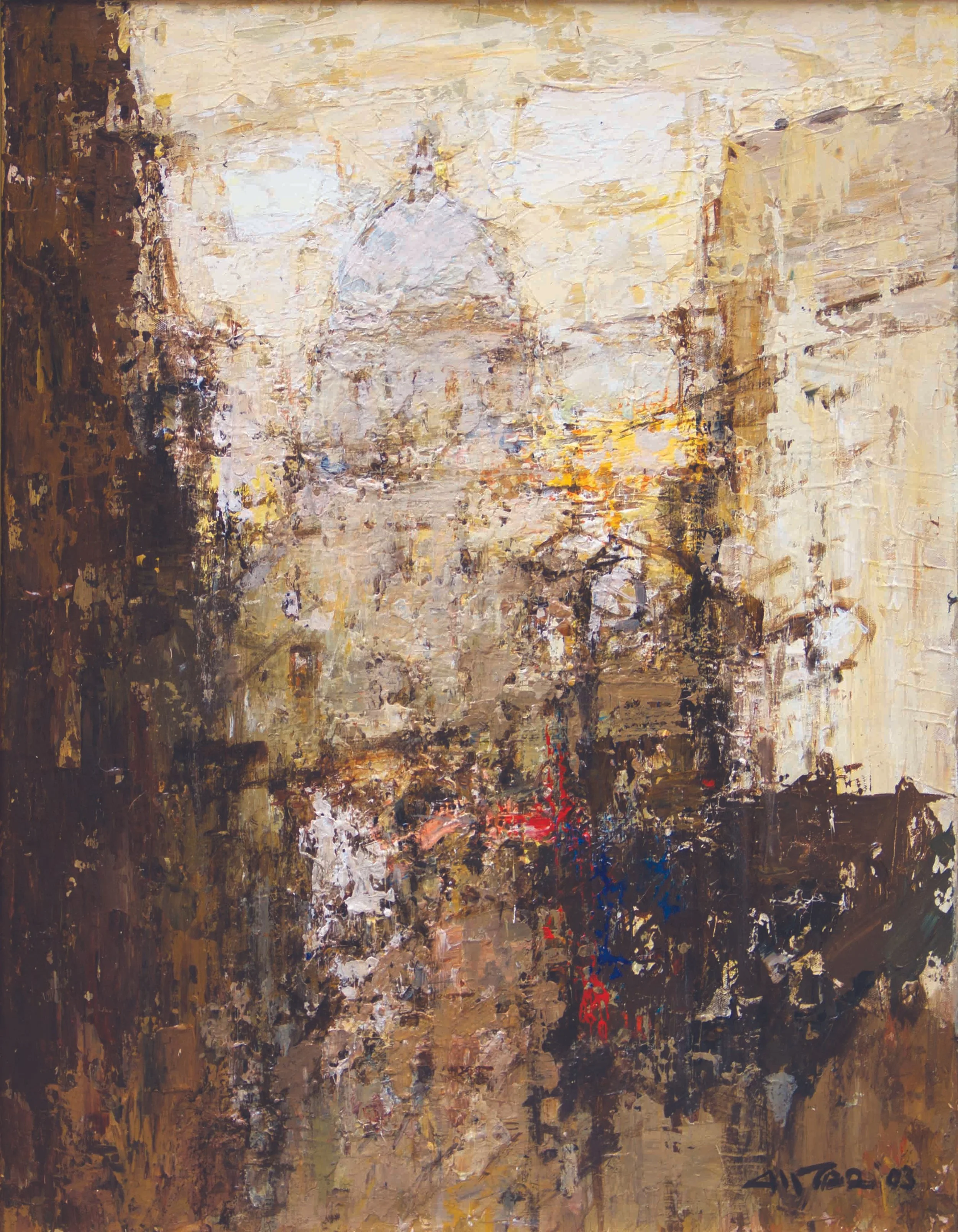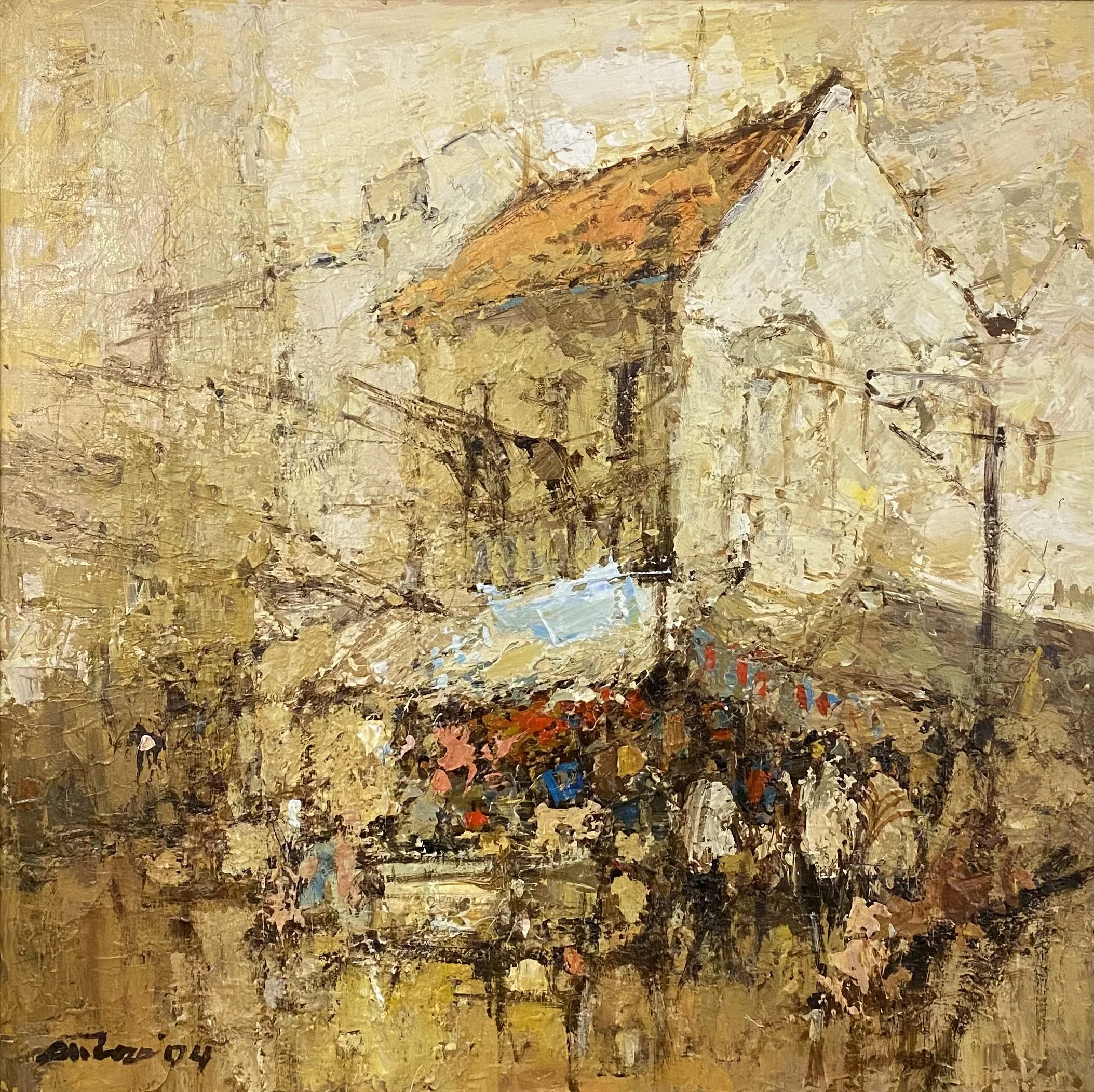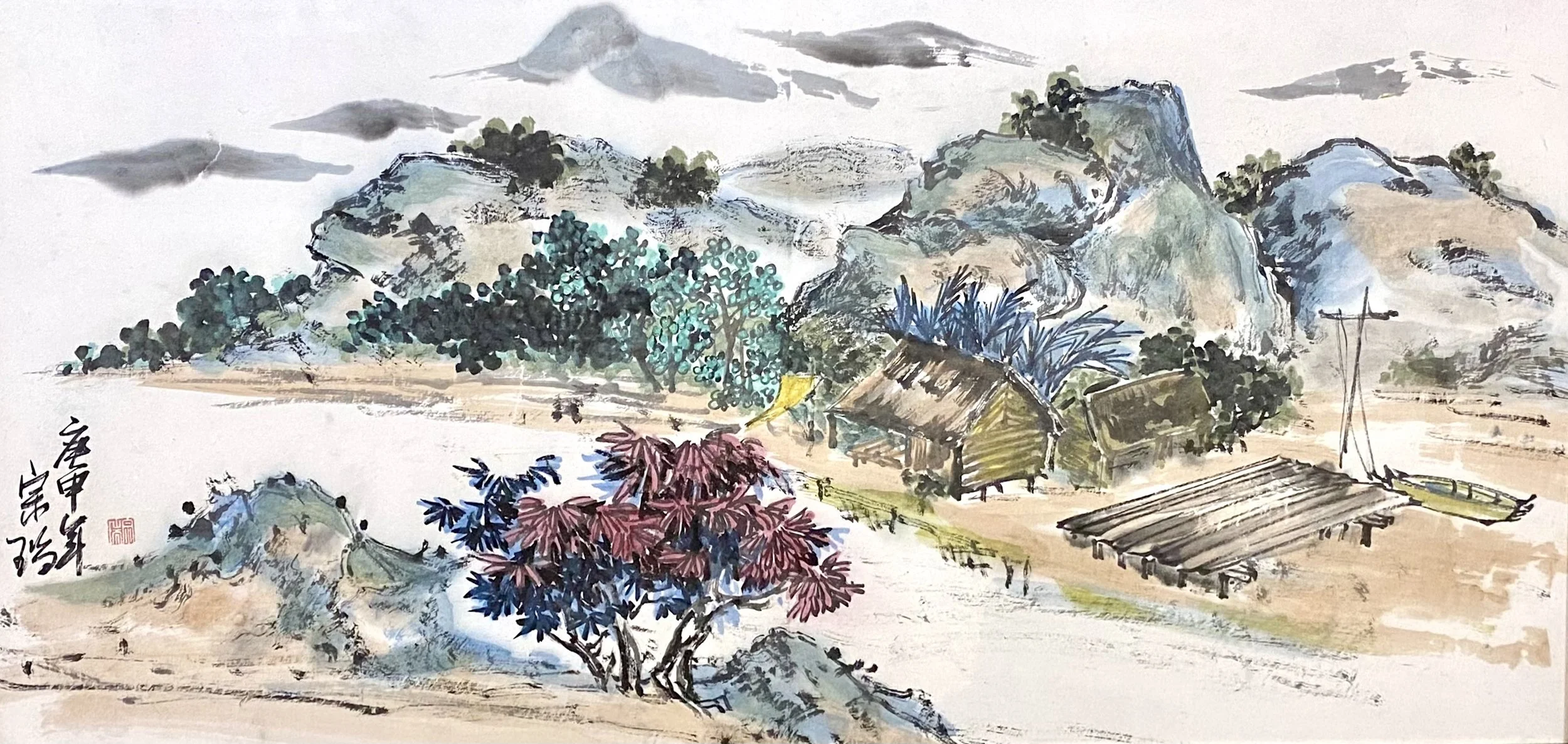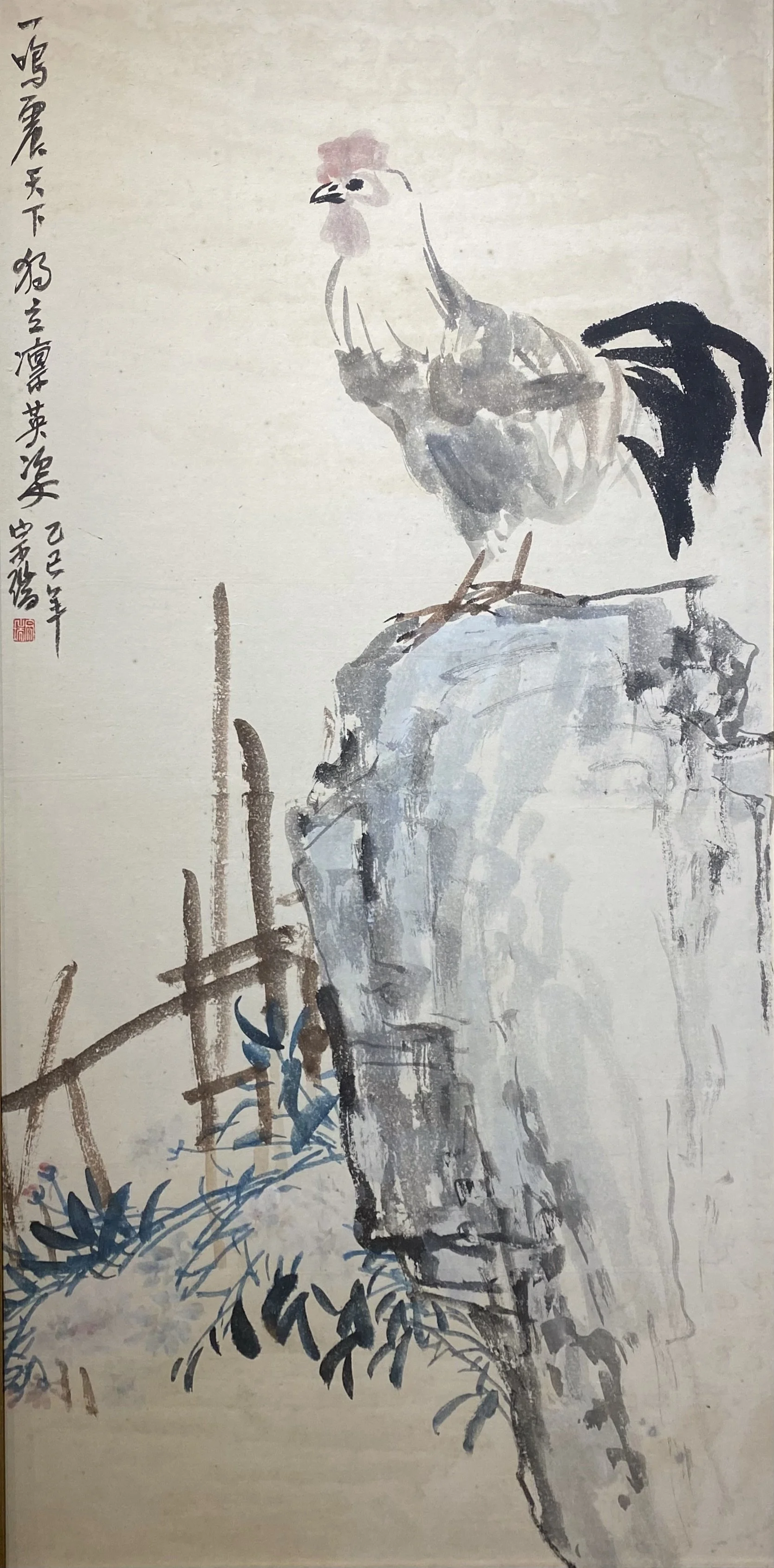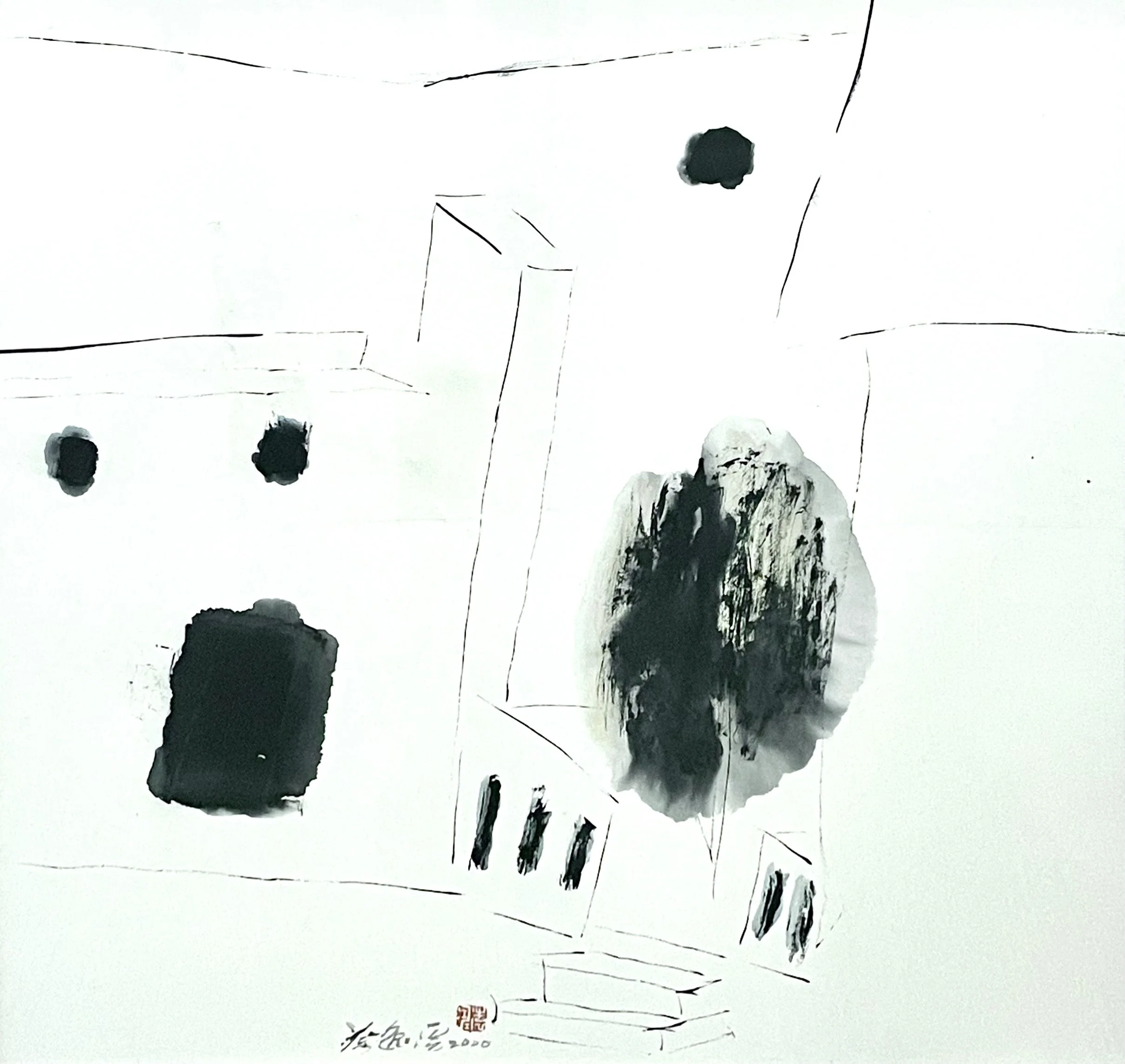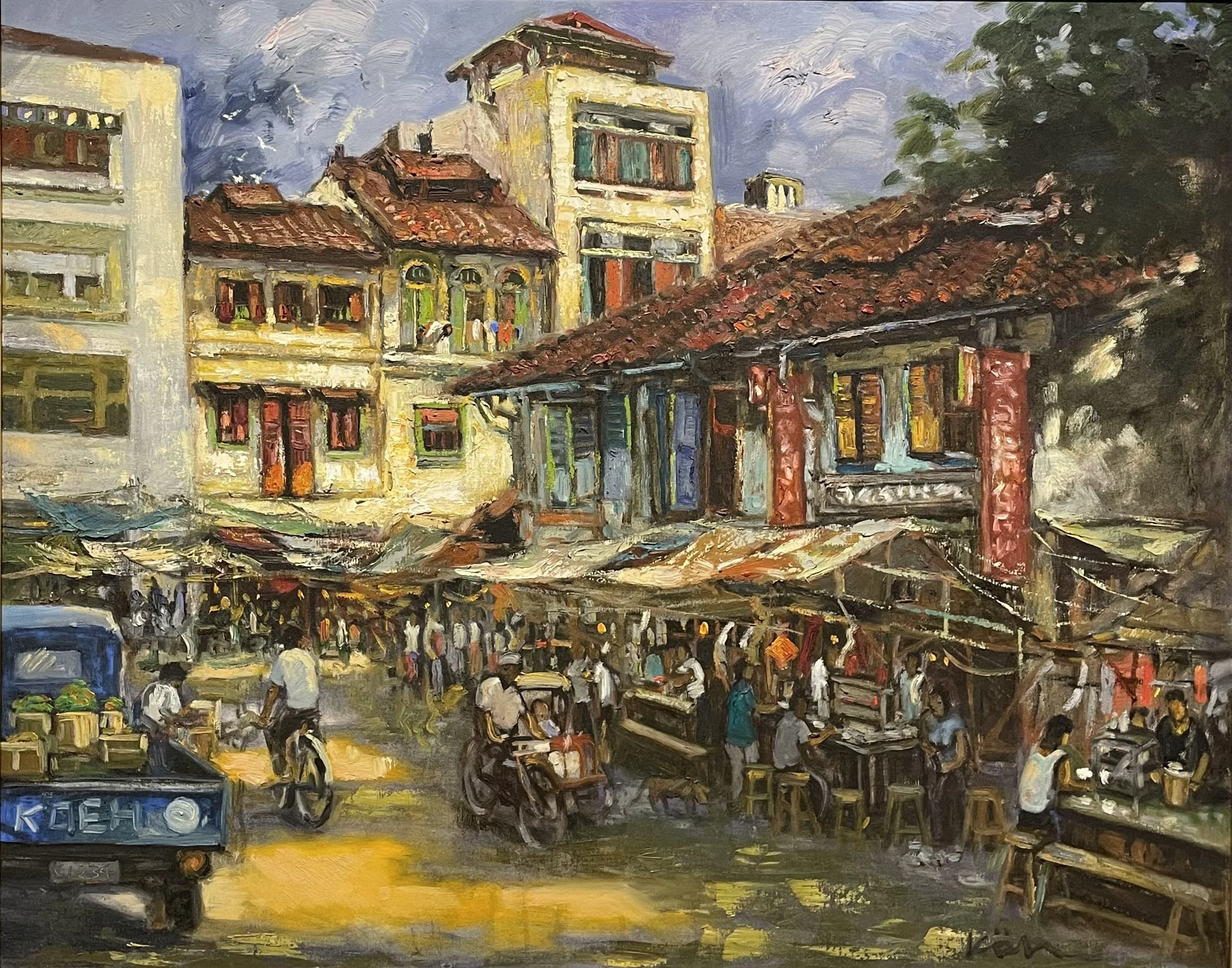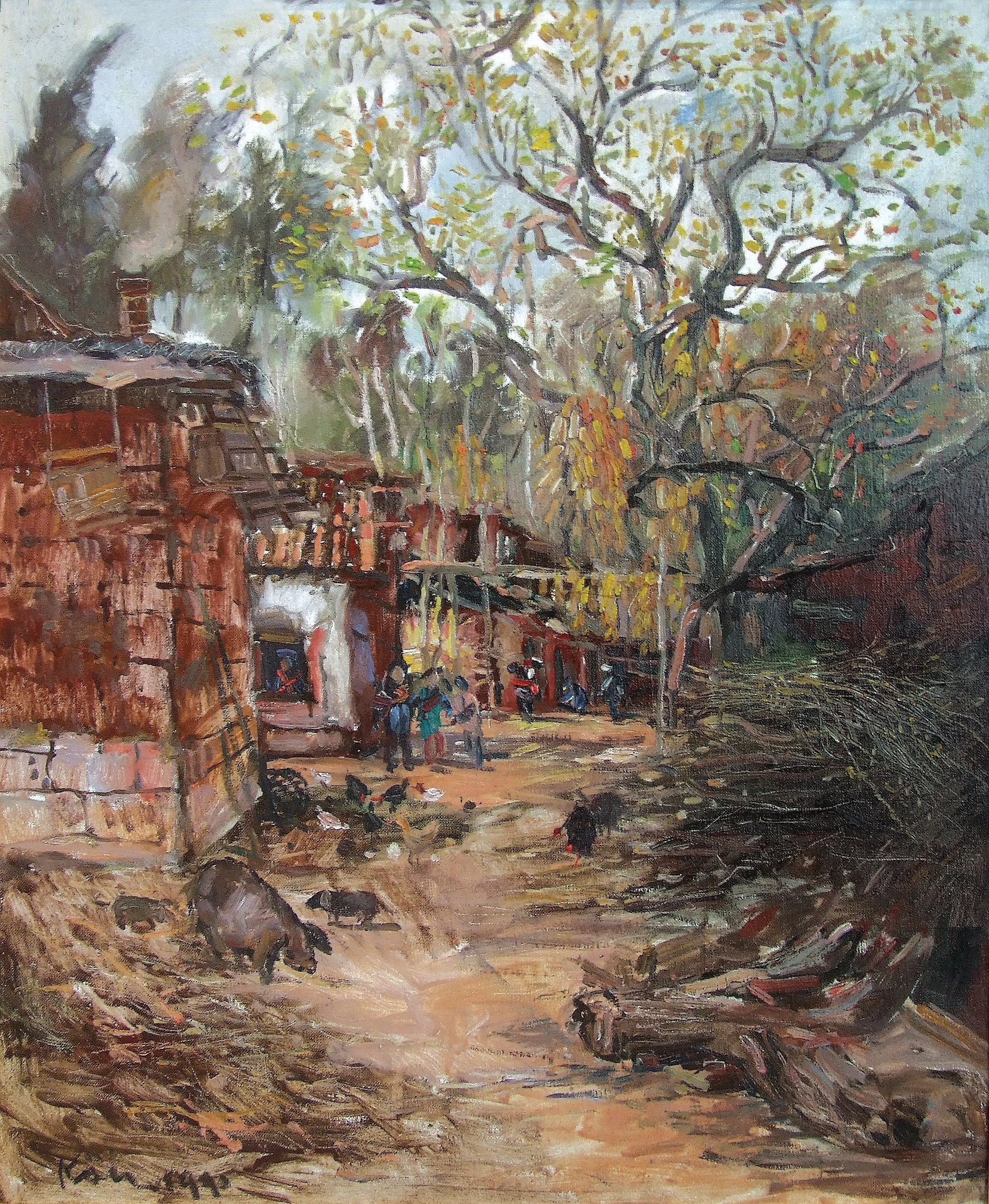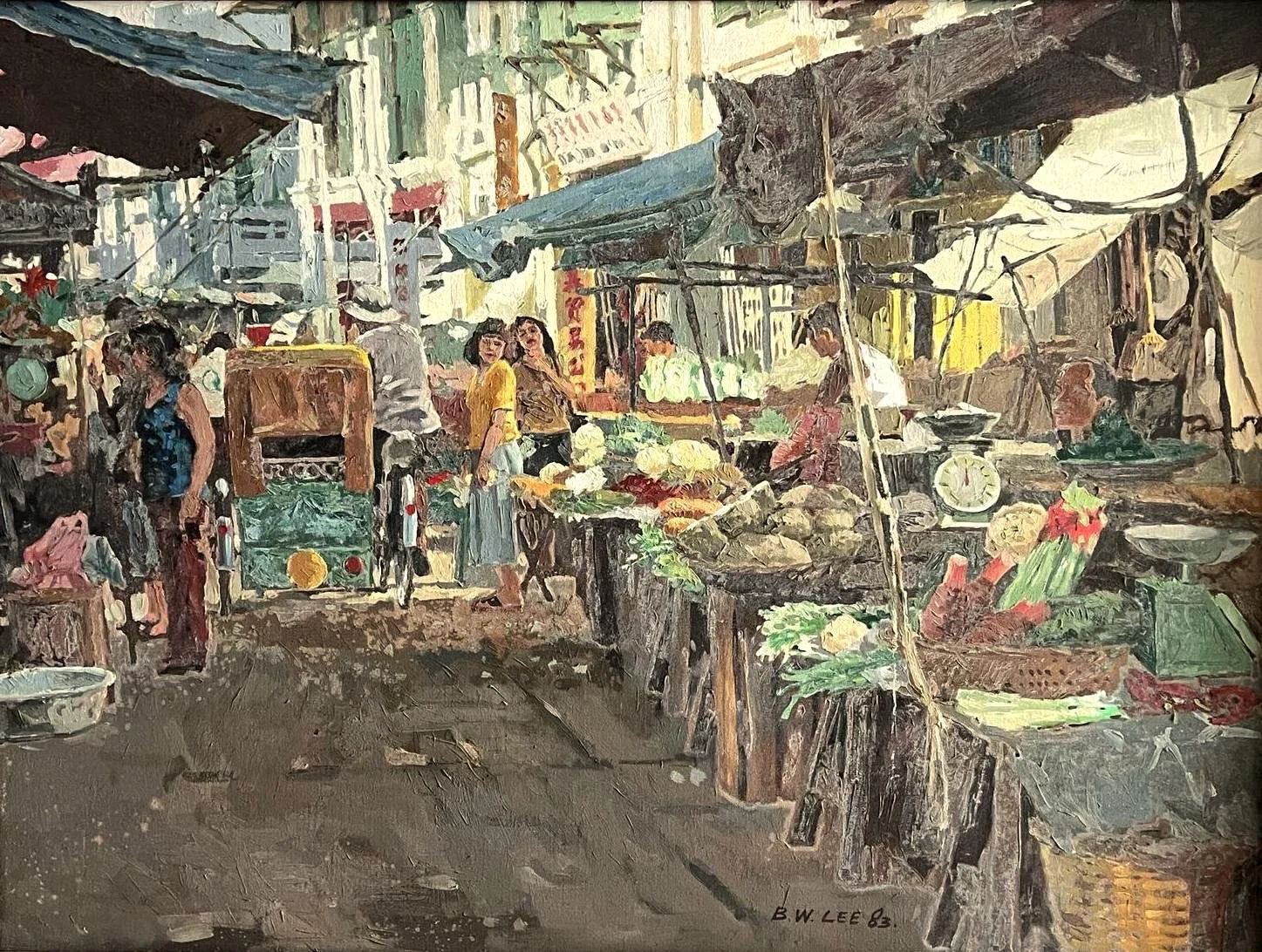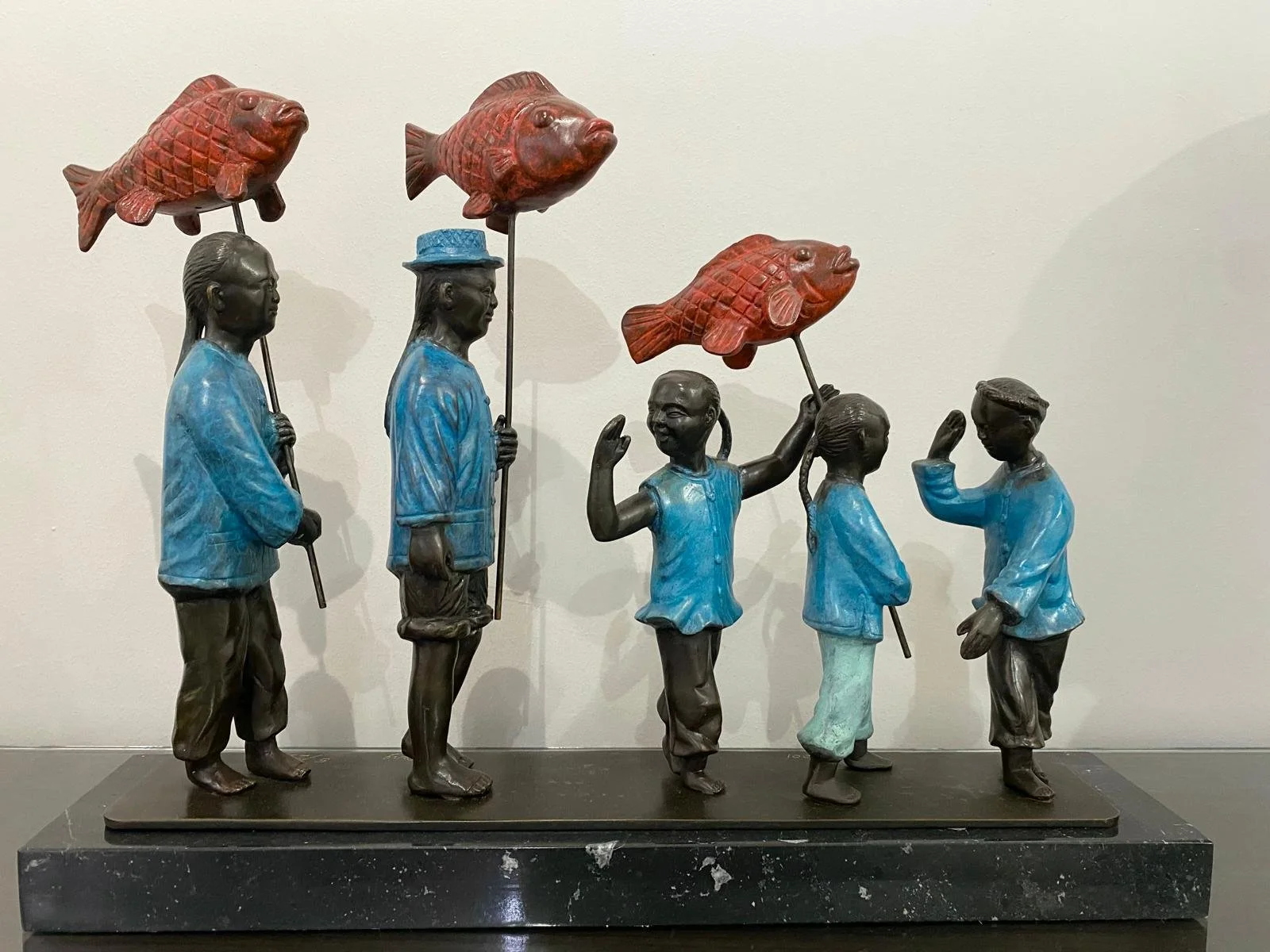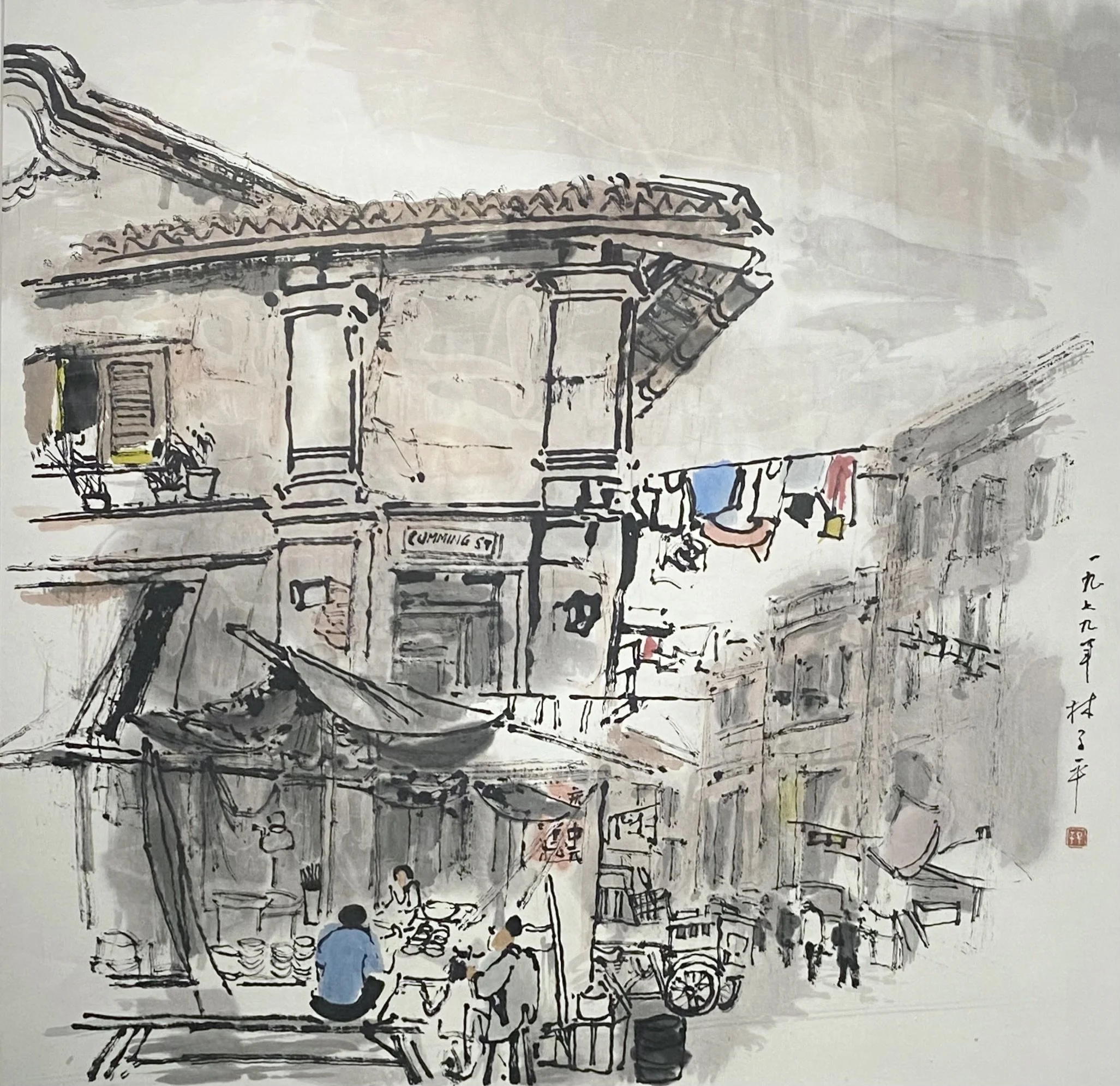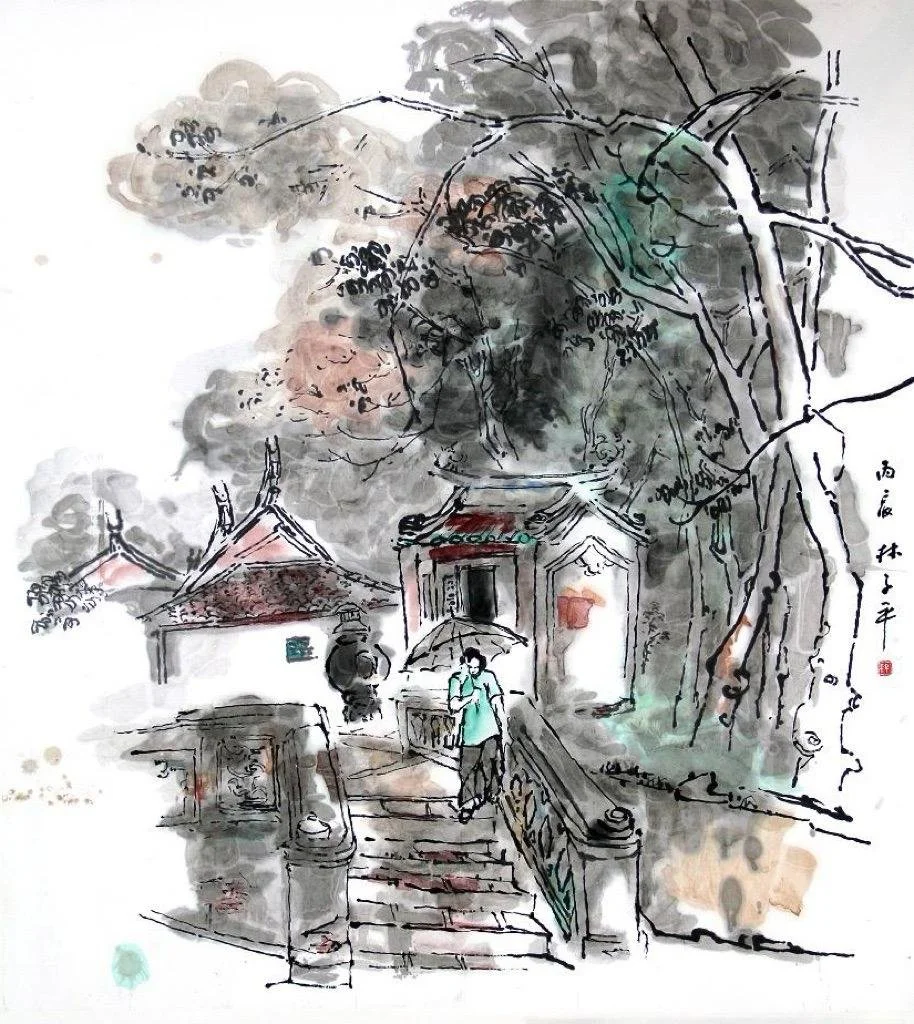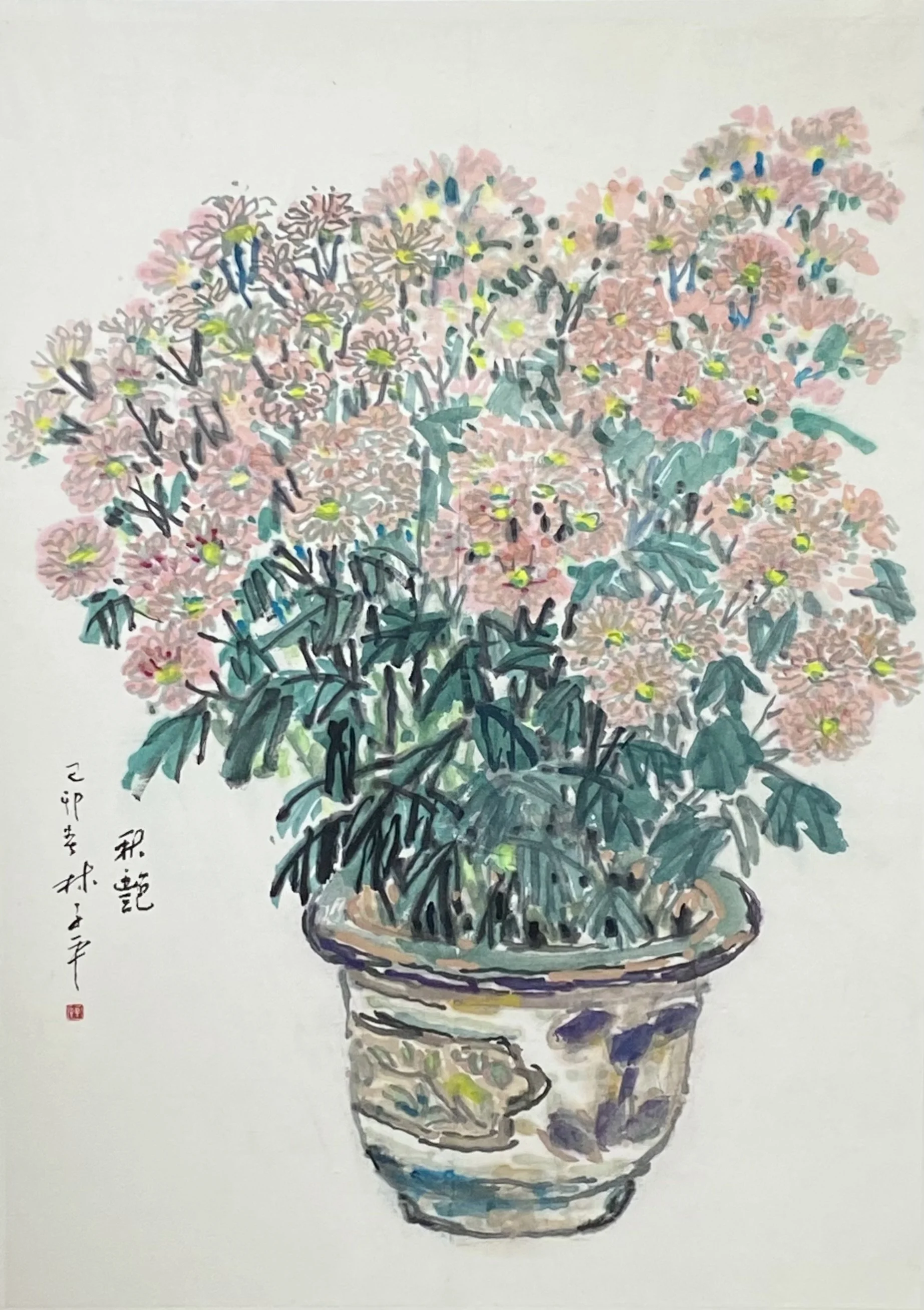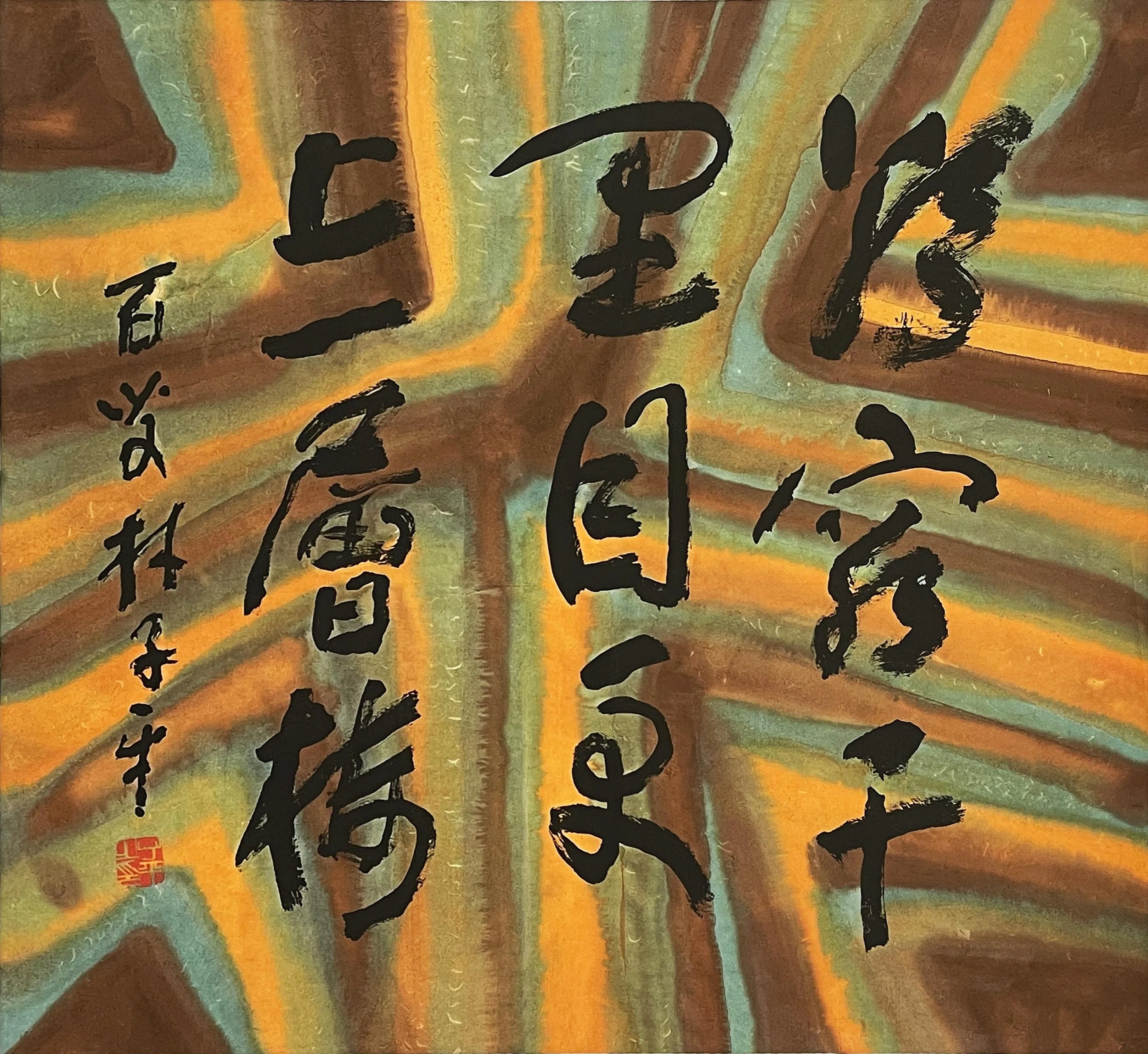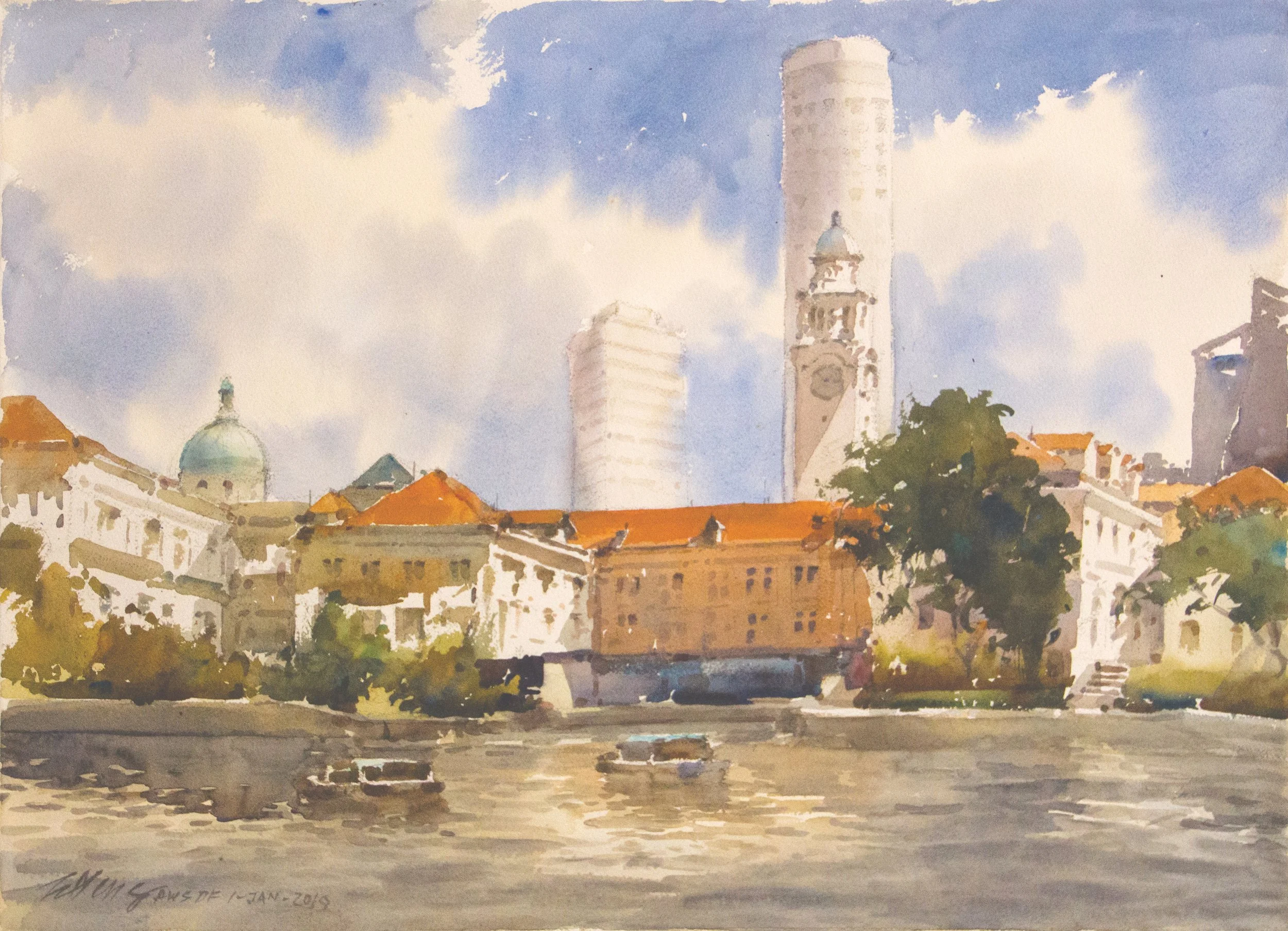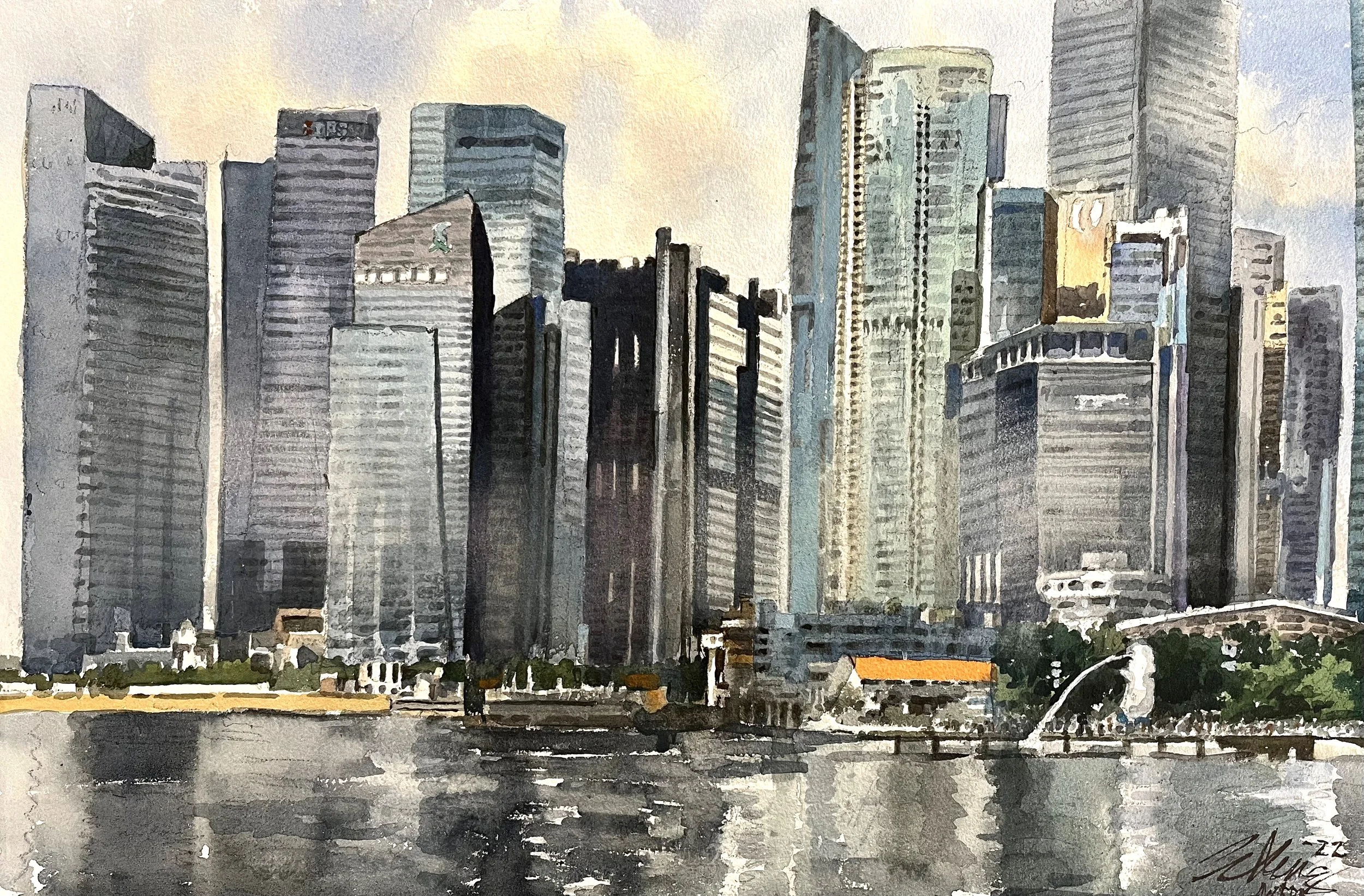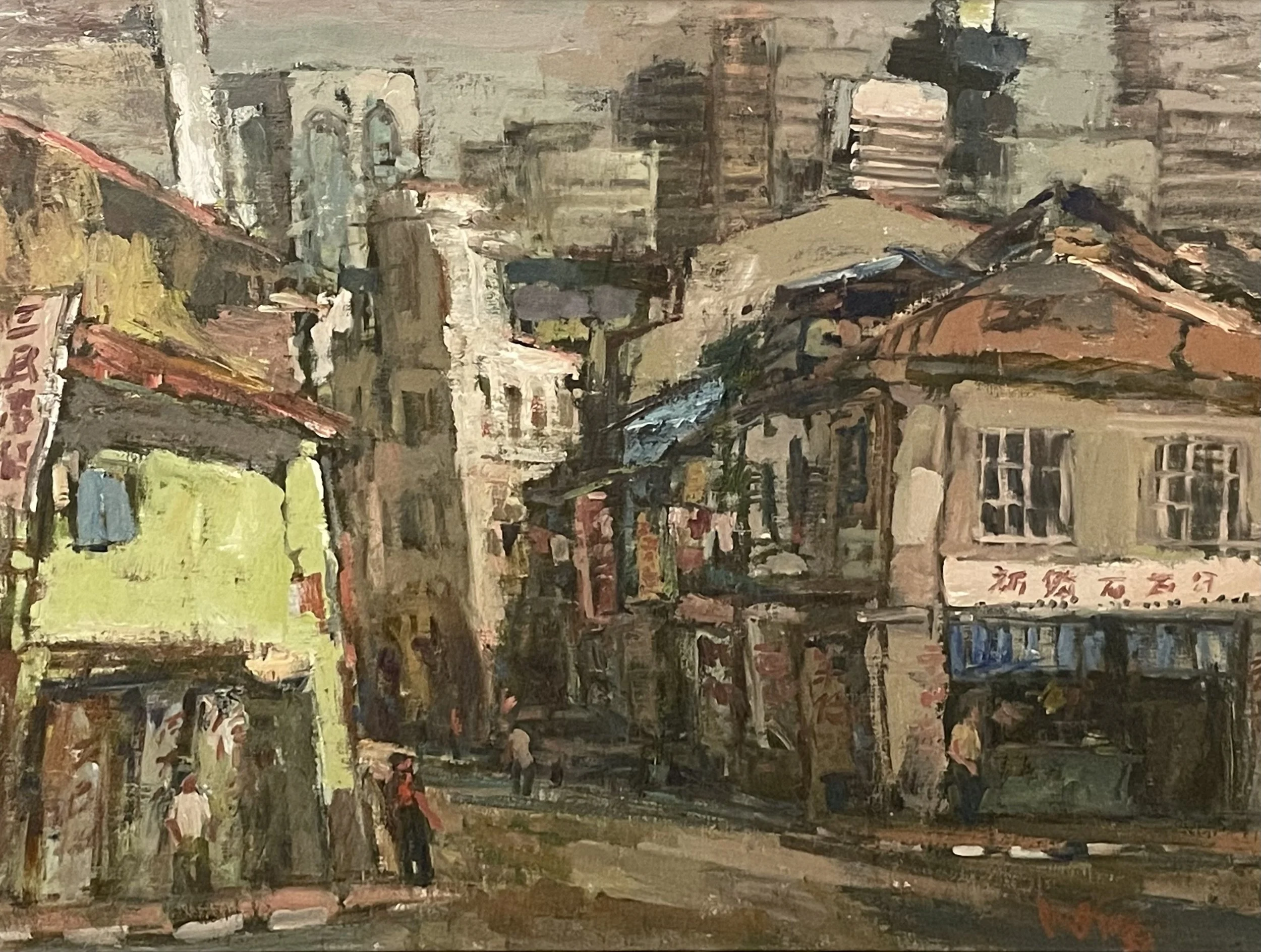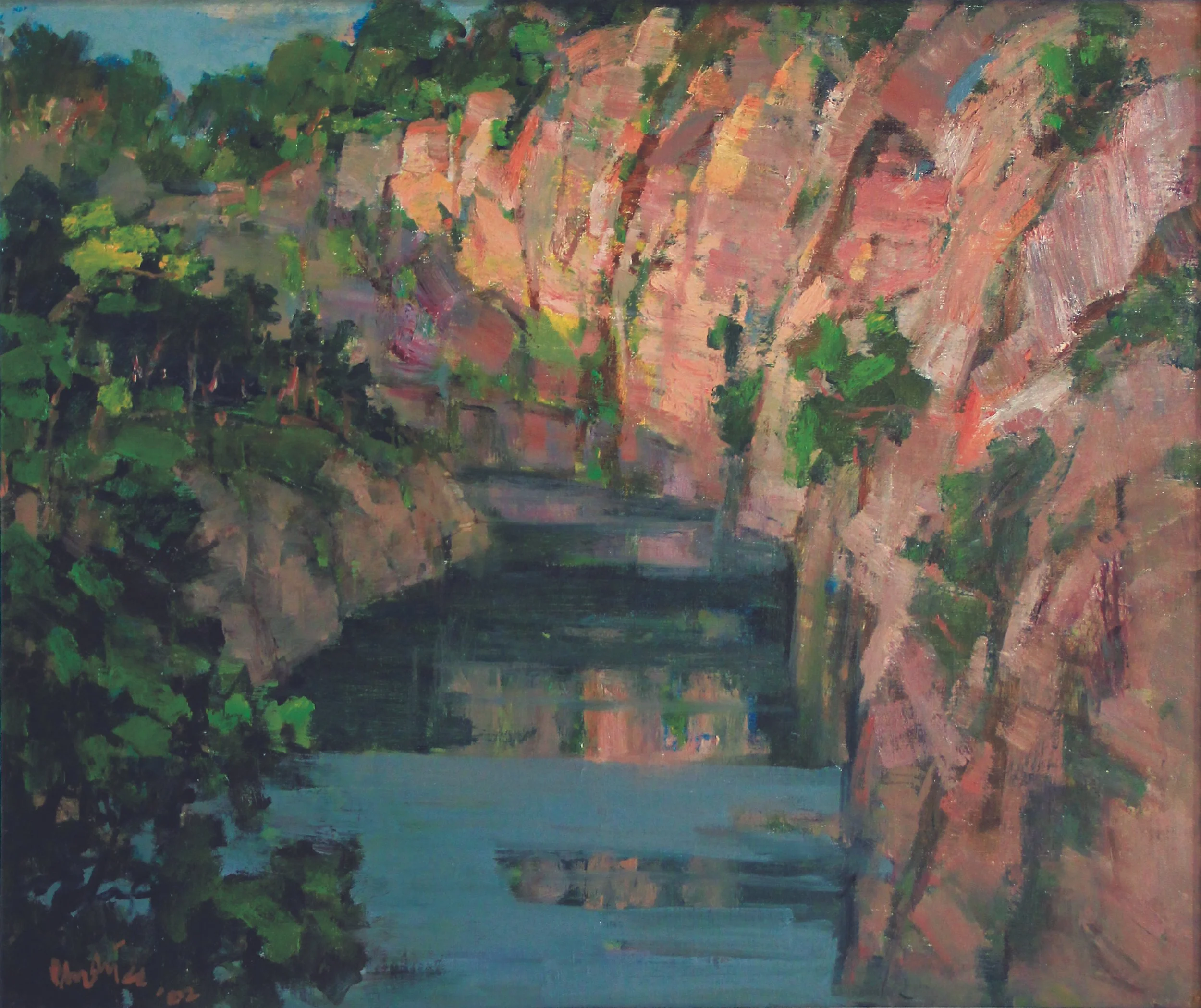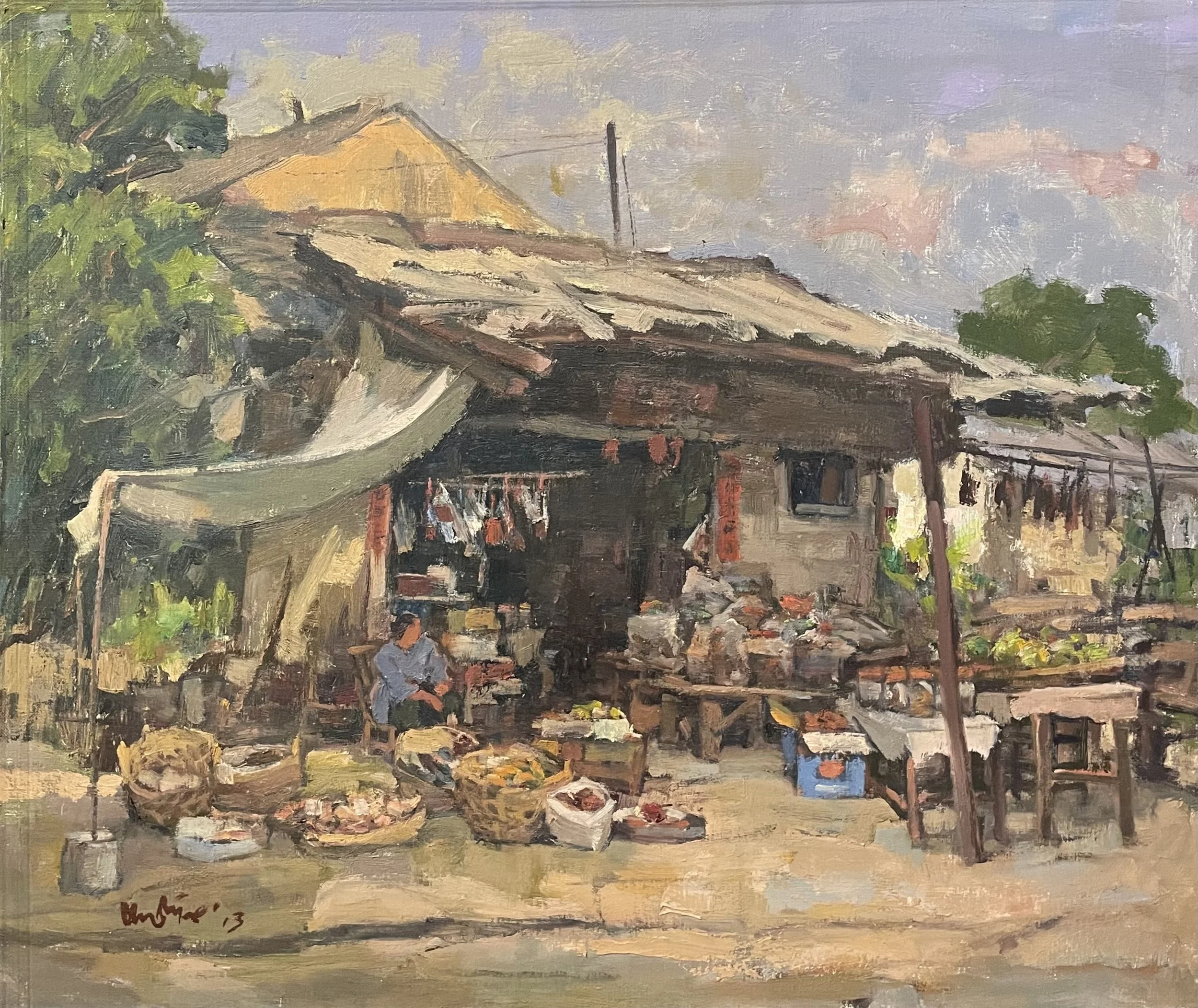This exhibition features a collection of paintings by well known Singaporean artists such as Ang Ah Tee, Chen Wen Hsi, Chua Ek Kay, Lim Tze Peng and Tan Choh Tee. Paintings of beautiful portraits created by artists from China such as Zhang Yi Bo, Li Zi Jian and Zeng Chuan Xing would also be on display. The event would be held at ION Art gallery, ION Orchard level 4 from 28 June to 6 July 2025.
Ang Ah Tee 洪亜弟
82 year old Mr Ang Ah Tee is a well known artist from Singapore famous for creating impressionistic and semi abstract paintings of beautiful scenes using the acrylic and oil mediums. Mr Ang studied at the Nanyang Academy of Fine Arts in the early 1960s and was taught by teachers such as Cheong Soo Pieng and Georgette Chen. He then went on to be a full time artist in the late 1970s. Mr Ang is known for experimenting with various mediums and painting different subject matters. He has created using the watercolour and acrylic mediums on board and paper in the early years of his practice. He has created paintings of Singapore street scenes using ink on paper. He has also painted and exhibited a series of still life objects in recent times. Mr Ang Ah Tee was conferred the Cultural Medallion Award by the National Arts Council in 2009.
Ang Ah Tee | High Street | 2003
82 岁的洪亚弟先生是新加坡著名的艺术家,以使用丙烯和油画媒介创作印象派和半抽象风格的画作而闻名。洪先生于 20 世纪 60 年代初就读于南洋艺术学院,师从钟泗滨和张荔英等先驱画家。洪亚弟先生在 20 世纪 70 年代末成为一名全职艺术家。洪先生以尝试各种媒介和题材而闻名。在他早期的创作中,他使用水彩和丙烯媒介在木板和纸上进行创作。他也曾用水墨在纸上创作新加坡街景的画作。近年来,他还创作并展出了一系列静物画。2009 年,洪亚弟先生被新加坡国家艺术理事会授予文化奖章。
Ang Ah Tee | Street Scene | 2004
Ang Ah Tee | Lunar New Year Celebrations | 2020
Ang Ah Tee | Chinatown
Ang Ah Tee | Ann Siang Hill
Chen Chong Swee 陈宗瑞 (1910-1985)
Mr Chen Chong Swee is one of the few well known pioneer artists in Singapore who specialised in creating paintings using the ink and watercolour mediums. Mr Chen travelled from China to Malaya and Singapore in the early 1930s and taught art at several schools such as Chung Cheng High School and Chinese High School. He became the head of Chinese painting at the Nanyang Academy of Fine Arts in the 1950s. Mr Chen painted many different subjects in his ink paintings throughout his practice. They include mountains, landscapes, villages, farmers, birds and flowers etc. He also wrote essays on art, discussing Chinese and western art. He also advocated for a centralised museum or gallery as well as a national collection for everyone in Singapore to enjoy art.
Chen Chong Swee | Landscape painting | 1980
陈宗瑞先生是新加坡少数几位著名的先驱艺术家之一,他擅长用水墨和水彩颜料进行创作。20 世纪 30 年代初,陈先生从中国来到马来亚和新加坡,并在中正中学和华侨中学等多所学校教授美术。20 世纪 50 年代,他成为南洋艺术学院的中国画系主任。在他的创作过程中,陈先生的水墨画主题多种多样,包括山水、风景、村庄、农民、鸟儿和花朵等。他还撰写艺术论文,探讨中西艺术。他还倡导建立国家博物馆、美术馆让新加坡的每一个人欣赏艺术作品。Chen Chong Swee | Soaring Mountains and Flowing Streams | 1956
Chen Chong Swee | Majestic Chicken |1965
Chua Ek Kay 蔡逸溪 (1947-2008)
Chua Ek Kay is a famous local artist known for his unique understanding and interpretations of the lotus pond and street scenes of Singapore. In several of Chua’s paintings of the lotus pond, he moved the lotus flower away from its stem, exaggerated on the size of the lotus leaves or repeatedly painted vertical and horizontal lines that represents the plant’s stem to form an abstract composition. These ideas reflect the artist’s intention to move away from traditional ways of painting the lotus pond and approach this classical subject matter in a creative manner. Chua Ek Kay also looks to bring across the beauties of lifecycles in nature, a theme that some artists have approached fleetingly in the past. He demonstrates this interest by painting flowers that are either budding, blooming and withering in different creations.
Chua Ek Kay | Morning Breeze
Chua Ek Kay | Fragrance of Lotus Pond | 2006
Chua Ek Kay | Impression of Shophouse | 2000
Chua Ek Kay returned from Hong Kong to Singapore in 1986, he developed the practice of painting outdoors. He would travel to places such as Beach Road, Tanjong Pagar or Chinatown to observe and paint the old shophouses. He observed that many of the old shops were torn down and replaced with modern high rise buildings. Many daily activities that took place because of the presence of these shops slowly ceased with the demolition of the old shops. That evoked some sadness and regret inspiring Chua to express these emotions through his paintings.
To bring across these feelings, Chua Ek Kay adopted the xieyi approach to illustrate the shophouses and street scenes. He would place greater emphasis on a handful of key elements on the architecture and street such as windows, doors or street signs. These elements served the purpose of capturing the viewers attention and allow them to imagine the rest of the surroundings. This conveyed the idea that some experiences and memories will remain visible and intact even when things are removed because of development and modernisation. This style of painting eventually developed into abstract compositions put together with beautiful ink washes, lines and dots.
CHEN WEN HSI 陈文希
In 1948, Chen Wen Hsi travelled to Singapore and staged an exhibition at the Chinese Chamber of Commerce. He was persuaded to settle in Singapore upon the expiration of his visa. He was then employed to teach art at both Chinese High School and NAFA. He retired from teaching in the 1960s.
Chen Wen Hsi specialised in Chinese ink painting. He painted many subjects such as gibbons, fishes, ducks, frogs, herons and sparrows. They were realistic and lively. Chen Wen Hsi was also known for utilising the finger-painting technique in his creations, making them unique when compared with other artists of his generation.
Chen Wen Hsi’s painting “Herons” was part of the National Gallery Singapore’s highlight programmer titled “My Masterpiece” where 12 significant artworks were selected and talked about by 12 well known personalities. His painting “Two Gibbons Amidst Vines” is featured on the reverse of the $50 not as part of the portrait Series of Currency notes released in 1999.
Chen Wen Hsi | Sparrows
Chen Wen Hsi | Herons
Chen Wen Hsi | 9 Koi Fish
Chua Mia Tee 蔡名智
94 years old this year, Mr Chua Mia Tee is one of the most famous artist in Singapore known for his highly realistic paintings. Mr Chua studied at the Nanyang Academy of Fine Arts during the late 1940s and early 1950s. He would go on to paint numerous portraits of people from the working class, businessmen, political leaders and presidents of Singapore. Mr Chua was also known for creating realistic paintings of sceneries, cityscapes and animals such as parrots and Koi Fish. In different interviews, Mr Chua shared that he was inspired by art catalogues of paintings by Rembrandt and Goya. In 2015, Mr Chua Mia Tee was conferred with the Cultural Medallion Award by the National Arts Council of Singapore. National Gallery Singapore held an exhibition of Mr Chua’s paintings titled “Directing The Reel” in 2022.
Chua Mia Tee | Koi Fish | 2006
Eng Siak Loy 翁锡礼
Mr Eng Siak Loy’s art career began with his training at the Singapore Academy of Art in the 1960s. He became the chief designer at the NParks thereafter. Mr Eng’s designs have played a key role in forging the branding and image of NParks. Mr Eng Siak Loy spent a lot of his time around flora and fauna in the gardens. He created sculptures and murals for the Gardens by the Bay and the Singapore Botanic Gardens. The botanic gardens’ Tanglin Gate, which features an intricate leaf motif design, was also his work. The time Mr Eng spent at the gardens culminated into a whole series of flower paintings which he created after he left his designer role at NParks. As Botanic Gardens celebrated her 150th anniversary, a solo exhibition was staged as a tribute to Mr Eng for his artistic contributions to the Gardens. A total of 30 oil paintings were showcased. During the event, the Singapore Botanic Gardens named an orchid after him ‘Dendrobium Eng Siak Loy’ as a special tribute to his contributions. Eng Siak Loy is the only visual artist in Singapore to receive such an honour.
Eng Siak Loy | Sensing Serenity | 2015
Eng Siak Loy | Flowers in the Wind | 2019
Eng Siak Loy | Beauty in the Wind | 2021
Eng Siak Loy | Pink Orchid | 2012
Ho Kah Leong 何家良
87 years old this year, Dr Ho Kah Leong is a celebrated artist and art educator in Singapore. Between 1955 and 1956, Dr Ho studied at the Nanyang Academy of Fine Arts. He then pursued a Bachelor of Science at Nanyang University and graduated in 1963. Dr Ho then joined the teaching profession for the next 10 years before joining politics. However, he never stopped painting and has been constantly active in the local art scene for more than six decades. He rejuvenated his passion and love for wood-cut prints after 50 years and launched a solo wood-cut exhibition in 2018 titled ‘Passion Rejuvenated’. The exhibition included portraits of artists, a series to depict the plight of refugees and scenes of daily life.
Ho Kah Leong | Commuting in the New Normal | 2020
Ho Kah Leong | Hold Thy Hand till the End | 2022
Ho Kah Leong | Singapore 1950 | 2023
Koeh Sia Yong 许锡勇
87 years old this year, Mr Koeh Sia Yong is a well known artist in Singapore. Mr Koeh studied western painting at the Nanyang Academy of Fine Arts in the the 1950s. It was also during that period that he joined the now defunct Equator Art Society that focused on paintings related to social issues and the working class. In the later part of his practice, Mr Koeh went on to paint a wide range of subject matters. They include nostalgic scenes of the Singapore River and street scenes during the 1980s and 1990s. He also painted sunflowers, places and people living in Bali. Several well known paintings by Mr Koeh Sia Yong can be found at the National Gallery Singapore. They include “Here They Come” a painting of street vendors appearing to run away from the police, “Persecution” a painting revolving around the atrocities of the Japanese Occupation in Singapore.
Koeh Sia Yong | Boon Tat Street | 1990s
Koeh Sia Yong | The Vanishing Kampong Siglap | 1988
Koeh Sia Yong | Sunflowers | 1999
Koeh Sia Yong | Village | 1992
Lee Boon Wang 李文苑 (1934-2016)
Lee Boon Wang graduated from the Nanyang Academy of Fine Arts in 1853 and lectured at the academy from 1955 to 1956. He was one of the founders of the Equator Art Society which reflected societal issues through realist art. Mr Lee’s paintings document a period of development and eventual progress in Singapore’s history.12 paintings by Lee Boon Wang were collected by the Sultan of Brunei and family in 1989. Lee Boon Wang held his last solo exhibition in 2016 and passed away in the same year.
Lee Boon Wang | Striving for a better future | 1984
Lee Boon Wang | Singapore River | 1984
Lee Boon Wang | Market | 1983
Lim Leong Seng 林龙成
Mr Lim Leong Seng is a famous Singaporean artist known for his sculptures. In the early 2000s, he created a series of sculptures that revolved around the working class in Singapore. They include realistic busts of Samsui women, coolies, milk sellers, barbers and fishmongers. Some of these were maquettes of large scale sculptures that were installed in public spaces, including “Lantern Procession” which can be found at Telok Ayer Green.
The artist is also the creator behind contemporary sculptures that include the piece titled “New Era” which is essentially a column of air-filled plastic bags that lies suspended from the ceiling. The artwork was one of his creations on display at “Nothing is Forever: Rethinking Sculpture in Singapore”, an exhibition held at the National Gallery Singapore in 2022. In 2024, Nanyang Academy of Fine Arts organised a solo exhibition for Lim Leong Seng. This exhibition is his ninth solo exhibition, exhibiting works that reflected Singapore’s development. The 40 over works exhibited included his sculptures, silkscreen paintings, and maquettes.
Lim Leong Seng | Mid Autumn Festival | 2001
Lim Leong Seng | Forgotten Memories A |2019
Lim Leong Seng | Blue Samsui B | 2019
Lim Leong Seng | Blue Samsui C | 2019
Lim Leong Seng | After a Hard Day’s Work | 2013
Lim Tze Peng 林子平 (1921-2025)
Mr Lim Tze Peng is one of Singapore’s most well known artist. His paintings have been exhibited widely in Singapore and in different parts of the world. Some of Mr Lim’s international shows were held at China’s National Art Museum in 2009, at the Dr. Bhau Daji Lad Museum in Mumbai, India during 2019 and Saatchi Gallery, London UK in 2023. Many exhibitions related to Mr Lim’s paintings were also held in Singapore. An example would be the exhibition titled “Becoming Lim Tze Peng” which was held at the National Gallery Singapore in 2024. Mr Lim Tze Peng was conferred the Cultural Medallion Award in 2003 for his artistic excellence and contributions to the arts in Singapore.
Lim Tze Peng | Street Scene | 1979
Lim Tze Peng | Pulau Ubin | 1998
Lim Tze Peng | Under the Shade | 1976
Lim Tze Peng | Scenery of Xi Tang |2004
Lim Tze Peng | Flowers | 1975
Lim Tze Peng | Singapore River Series-A Romantic Expression
Lim Tze Peng | Colour Calligraphy 欲穷千里目更上一层楼
Lim Tze Peng | Charming History | 2021
Lim Tze Peng | Berth - Singapore River | 2007
Liu Kang 刘抗 (1911-2004)
Liu Kang is a well known pioneer artist from Singapore. He studied at famous institutions such as the Shanghai College of Fine Arts in China and Académie de la Grande Chaumière in France during the 1920s to 1930s before coming to Singapore in the late 1930s. Liu Kang created many paintings that were inspired by his surroundings in Singapore and from his sight seeing trips at different countries in Southeast Asia. They include village scenes, street scenes, people from the working class as well as women and farmers in Bali. Liu Kang contributed to the local art scene in many ways. He was a founding member of the Singapore Art Society and led the Society in the late 1960s to 1970s. Liu Kang exhibited his paintings on numerous occasions in Singapore, for instance a show of around 200 paintings were displayed at the National Museum in the 1980s. He donated a large body of his paintings to the Singapore Art Museum in 2003, a year before his passing.
Liu Kang | Kampong Life | 1983
Liu Kang | Sisters | 1997
Nai Swee Leng 赖瑞龙
79 year old Mr Nai Swee Leng is famous for creating beautiful paintings of birds, fishes and flowers using the ink medium.
Mr Nai received the Lifetime Achievement Award from the Singapore Siaw-Tao Seal Carving anf Calligraphy Art Society in 2005. In 2016, Mr Nai was invited by the National Gallery Singapore to share on the development of ink painting during the Ming and Qing Periods as part of the Ink Masters Series.
Mr Nai is also passionate about bringing his paintings to the heartlands so more people can enjoy art. In 2019, he held an exhibition at Tiong Bahru Community Centre and live painting demonstration. Mr Nai’s paintings were showcased by our gallery during two exhibitions. They were held at ION Art Gallery in 2016 and at Bras Basah Complex level 3 in 2024.
Nai Swee Leng | Goldfish Under the Vines | 2016
Nai Swee Leng | Mynahs and Bougainvillea | 2015
Ong Kim Seng 王金成
Mr Ong Kim Seng is one of Singapore’s most famous watercolour artist. He is known for creating beautiful paintings of Singapore and scenes inspired by his travels to different places around the world. Mr Ong was presented with the Cultural Medallion winner in 1990. It was also in that year that he was conferred membership in the prestigious American Watercolour Society (AWS). Mr Ong is the first Singaporean to have won six awards from the AWS and was thus conferred the society’s Dolphin Fellowship in 2000.
Ong Kim Seng | Afternoon at Boat Quay | 2019
Ong Kim Seng | Modern Singapore | 2022
Ong Kim Seng | Scene of Bali | 2016
Ong Kim Seng | By the River |2022
Tan Choh Tee 陈楚智
Tan Choh Tee is a well known artist from Singapore. He studied at the Nanyang Academy of Fine Arts in the late 1950s and graduated in the early 1960s. He went on to work at a Publications Company till the mid 1970s. He was already painting and selling his paintings while working in his day job. Mr Tan recounted that he sold a small number of his paintings to westerners who came to Singapore to buy artworks in bulk. Mr Tan decided to quit his job in 1976 and become a full time artist despite being offered a pay raise as he felt that it was not possible to work for the company his whole life and he wanted to pursue his own interest. He also felt that he found that the buildings in Singapore were being demolished even before he could complete the paintings he started on. He felt the urge to concentrate on his painting.
In 1976, Tan Choh Tee was selected to exhibit at the National Day Art Exhibition. This national exhibition was an important show at that time, there was a catalogue published in conjunction to the show. The National Day Art Exhibition was held at Victoria Memorial Hall and was a serious event. It was also in the same year that he held his second solo exhibition at Raya Gallery. In 1979, Tan Choh Tee was invited to have a solo exhibition at the National Museum. He remembers that he exhibited around 10 of his paintings during that show.
In the 1980s, Tan Choh Tee had the opportunity to exhibit his paintings in Taiwan. At that time, there was not much of a market in Singapore and it was very difficult to sell paintings. Most of the paintings in Singapore at that time were bought by Indonesians, Westerners or Taiwanese. Tan Choh Tee held 5 to 6 exhibitions in Taiwan including places like Kaoshiung, Taichung and Taipei. Mr Tan was very serious about the exhibitions in Taiwan. If there was a show that was planned for the end of the year, he would travel to Taiwan and spend 20 over days to paint at different parts of Taiwan in the beginning of the year and bring the whole collection back to Singapore to apply the finishing touches before bringing them back to Taiwan at the end of the year.
In 1984, Tan Choh Tee agreed to teach part time at the Nanyang Academy of Fine Arts. It was also in this year that the academy worked with Tan Choh Tee to send him to the Central Academy of Fine Arts. Tan Choh Tee spent 6 months in Beijing and It was there that he attended the master’s class. After 6 months at Central Academy of Fine Arts, Tan Choh Tee applied to go to the Dunhuang Academy China.
Tan Choh Tee | Circular Road | 1988
Tan Choh Tee | Mohamed Sultan Road | 1991
Tan Choh Tee | Nostalgic Old Town | 2004
Tan Choh Tee | The Quarry | 2002
Tan Choh Tee | Arab Street | 2006
Tan Choh Tee | Stall | 2013



